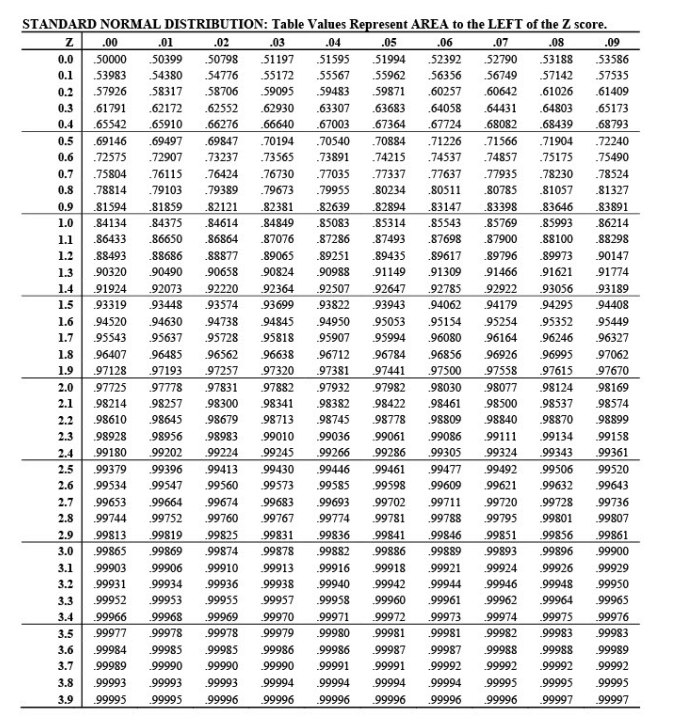UNIT 5: INTRODUCTION TO PROBABILITY
Key unit Competence: Use probability concepts to solve mathematical. Production,
financial, and economical related problems and drawappropriate decisions
Introductory activity
The following data were collected by counting the number of Warehouses in
use at MAGERWA over a 20 day period. 3 of the 20 days, only 1 Warehouse
was used, 5 of the 20 days, 2 Warehouses were used; 8 of the 20 days, 3
Warehouses were used; and 4 of the 20 days, 4 warehouses were used.
a) Construct a probability distribution for the data
b) Draw a graph for the probability distribution
c) Show that the probability distribution satisfies the required conditions for
a discrete probability distribution.d) On your own side defend why probability is important.
5.1. Key Concepts of probability
5.1.1. Definitions of probability terminologies
Learning activity 5.1.1
Consider the deck of 52 playing cards

1. Suppose that you are choosing one card
a) How many possibilities do you have for the cards to be chosen?
b) How many possibilities do you have for the kings to be chosen?
c) How many possibilities do you have for the aces of hearts to bechosen?
2. If “selecting a queen is an example of event, give other examples of
events.
Probability is random variable that can be happen or not, i.e. is the chance
that something will happen. Using the following examples, we can see how theconcept of probability can be illustrated in various contexts
Let us consider a game of playing cards. In a park of deck of 52 playing cards,
cards are divided into four suits of 13 cards each. If any player selects a card
by random (simple random sampling: chance of picking any card in the park is
always equal), then each card has the same chance or same probability of beingselected.
Second example, assume that a coin is tossed, it may show Head (H-face withlogo) or tail(T-face with another symbol), all these are mentioned below:
We cannot say beforehand whether it will show head up or tail up. The result
will depend on chance. The same, a card drawn from a well shuffled pack of 52
cards can be red or black. This also depends on chance. All these phenomena
are called probabilistic, means that can be occurred depending on the chance/uncertainty. The theory of probability is concerned with this type of phenomena.
Probability is a concept which numerically measures the degree of uncertaintyand therefore certainty of occurrence of events.
In accounting, the sample of some documents and audited, then results
obtained in this sample will be generalized to the whole documents with
supporting recommendations to that particular accountant, institutions, andfurther decisions might be done basing on the findings obtained in the sample.
• Random experiments and Events
A random experiment is an experiment whose outcome cannot be predicted
or determined in advance. These are some example of experiments: Tossing
a coin, throwing a dice, selecting a card from a pack of paying cards, etc. In all
these cases there are a number of possible results (outcomes) which can occurbut there is an uncertainty as to which one of them will actually occur.
Each performance in a random experiment is called a trial. The result of a trial
in a random experiment is called an outcome, an elementary event, or a sample
point. The totality of all possible outcome (or sample points) of a random
experiment constitutes the sample space (the set of all possible outcomes of
a random experiment) which is denoted by Ω . Sample space may be discrete(single values), or continuous (intervals).
Discrete sample space:
• Firstly, the number of possible outcomes is finite.
• Secondly, the number of possible outcomes is countable infinite,
which means that there is an infinite number of possible outcomes,
but the outcomes can be put in a one-to-one correspondence with thepositive integers.

Continuous sample space
If the sample space contains one or more intervals, the sample space is thenuncountable infinite.
Example:
A die is rolled until a “6” is obtained and the time needed to get this first “6” is
recorded. In this case, we have to denote that
An event is a subset of the sample space. The null set φ is thus an event known
as the impossible event. The sample space Ω corresponds to the sure event.
In particular, every elementary outcome is an event, and so is the sample spaceitself.



Note: The determination of sample space for some events such as the one for
dice thrown simultaneously requires the use of complex reasoning but it can
be facilitated by different counting techniques. Morever,the number of possible
arrangements for a given set is calculated mathematically, and this process isknown as permutation.
Permutation
Permutation is a term that refers to the variety of possible arrangements or
orders. The arrangement’s order is important when using permutations.
Permutations come in three varieties, one without repetition and two withrepetition. There is a way you can calculate permutations using a formula

Example 2
Consider a portfolio manager of a bank screened out 10 companies for a new
fund that will consist of 3 stocks. These 3 holdings will not be equal-weighted,
which means that ordering will take place. Help the manager to find out thenumber of ways to order the fund.

Combinations
In contrast to permutations, the combination is a method of choosing things
from a collection when the order of the choices is irrelevant. This means that a
combination is the choice of r things from a set of n things without replacementand where order does not matter.

Example
In a bank, the manager organizes election of bank committees consisting with
men and women. In how many ways a committee consisting of 5 men and 3women, can be chosen from 9 men and 12 women?

Application activity 5.1.1
1. A box contains 5 red, 3 blue and 2 green pens. If a pen is chosen at
random from the box, then which of the following is an impossible
event?
a) Choosing a red pen
b) Choosing a blue pen
c) Choosing a yellow pend) None of the above
2. Which of the following are mutually exclusive events when a day of
the week is chosen at random?
a) Choosing a Monday or choosing a Wednesday
b) Choosing a Saturday or choosing a Sunday
c) Choosing a weekday or choosing a weekend dayd) All of the above
3. Two dice are thrown simultaneously and the sum of points is noted,determine the sample space.
5.1.2. Empirical rules, axioms and theorems
Learning activity 5.1.2
Consider the letters of the word “PROBABILITY”.
a) How many letters are in this word?
b) How many vowels are in this word?
c) What is the ratio of numbers of vowels to the total number of letters?
d) How many consonants are in this word?
e) What is the ratio of numbers of consonants to the total number of
letters?f) Let A be the set of all vowels and B the set of all consonants. Find
i. A ∩B
ii. A ∪B
iii. A'
iv. B'



Application activity 5.1.2
1. A letter is chosen from the letters of the word “MATHEMATICS”.What is the probability that the letter chosen is M? and T?
2. An integer is chosen at random from the set
S = {all positive integers less than 20} . Let A be the event of choosinga multiple of 3 and let B be the event of choosing an odd number. Find
a) P ( A∪ B)
b) P (A ∩B )
c) P (A − B)
5.1.3 Additional law of probability, Mutual exclusive, and exhaustive
Learning activity 5.1.3
Consider a machine which manufactures car components. Suppose each
component falls into one of four categories: top quality, standard,substandard, reject
After many samples have been taken and tested, it is found that under certain
specific conditions the probability that a component falls into a category is
as shown in the following table. The probability of a car component fallinginto one of four categories.
The four categories cover all possibilities and so the probabilities must
sum to 1. If 100 samples are taken, then on average 18 will be topquality, 65 of standard quality, 12 substandard and 5 will be rejected.
Using the data in table determine the probability that a component selectedat random is either standard or top quality.




Solution:
Since only one person wins, the events are mutually exclusive.
3. Machines A and B make components. Machine A makes 60% of the
Components. The probability that a component is acceptable is 0.93 when
made by machine A and 0.95 when made by machine B. A component ispicked at random. Calculate the probability that it is:
a) Made by machine A and is acceptable.
b) Made by machine B and is acceptable.c) Acceptable.

Application activity 5.1.3
1. A fair die is rolled, what is the probability of getting an even numberor prime number?
2. Events A and B are such that they are both mutually exclusive andexhaustive. Find the relation between these two events.
3. In a class of a certain school, there are 12 girls and 20 boys. If a
teacher want to choose one student to answer the asked question
a) What is the probability that the chosen student is a girl?
b) What is the probability that the chosen student is a boy?
c) If teacher doesn’t care on the gender, what is the probability ofchoosing any student?
4. On New Year’s Eve, the probability of a person driving while
intoxicated is 0.32, the probability of a person having a driving
accident is 0.09, and the probability of a person having a drivingaccident while intoxicated is 0.06.
What is the probability of a person driving while intoxicated or having adriving accident?
5.1.4 Independence, Dependence and conditional probability
Learning activity 5.1.4
Suppose that you have a deck of cards; then draw a card from that deck,not replacing it, and then draw a second card.
a) What is the sample space for each event?
b) Suppose you select successively two cards, what is the probability ofselecting two red cards?
c) Explain if there is any relationship (Independence or dependence)
between those two events considering the sample space. Does theselection of the first card affect the selection of the second card?








Contingency table
Contingency table (or Two-Way table) provides a different way of calculating
probabilities. It helps in determining conditional probabilities quite easily. The
table displays sample values in relation to two different variables that may bedependent or contingent on one another.
Below, the contingency table shows the favorite leisure activities for 50 adults,
20 men and 30 women. Because entries in the table are frequency counts, thetable is a frequency table.
Entries in the total row and total column are called marginal frequencies or
the marginal distribution. Entries in the body of the table are called jointfrequencies.
Example
Suppose a study of speeding violations and drivers who use car phonesproduced the following fictional data:

Calculate the following probabilities using the table:
a) P(person is a car phone user)
b) P(person had no violation in the last year)
c) P(person had no violation in the last year AND was a car phone user)
d) P(person is a car phone user OR person had no violation in the last year)
e) P(person is a car phone user GIVEN person had a violation in the lastyear)


Application activity 5.1.4
1. A dresser drawer contains one pair of socks with each of the
following colors: blue, brown, red, white and black. Each pair is
folded together in a matching set. You reach into the sock drawer
and choose a pair of socks without looking. You replace this pair
and then choose another pair of socks. What is the probability thatyou will choose the red pair of socks both times?
2. A coin is tossed and a single 6-sided die is rolled. Find the probabilityof landing on the head side of the coin and rolling a 3 on the die.
4. The world-wide Insurance Company found that 53% of the residents
of a city had home owner’s Insurance with its company of the
clients, 27% also had automobile Insurance with the company. If a
resident is selected at random, find the probability that the resident
has both home owner’s and automobile Insurance with the worldwide Insurance Company.
5. Calculate the probability of a 6 being rolled by a die if it is alreadyknown that the result is even.
6. A jar contains black and white marbles. Two marbles are chosen without
replacement. The probability of selecting a black marble and then a
white marble is 0.34, and the probability of selecting a black marble on
the first draw is 0.47. What is the probability of selecting a white marbleon the second draw, given that the first marble drawn was black?
5.1.5. Tree diagram, Bayes theorem and its applications
Learning activity 5.1.5
1. A box contains 4 blue pens and 6 black pens. One pen is drawn at
random, its color is noted and the pen is replaced in the box. A pen isagain drawn from the box and its color is noted.
a) For the 1st trial, what is the probability of choosing a blue pen andprobability of choosing a black pen?
b) For the 2nd trial, what is the probability of choosing a blue pen and
probability of choosing a black pen? Remember that after the 1st trialthe pen is replaced in the box.
2. In the following figure complete the missing colours and probabilities

a) Tree diagram
A tree diagram is a tool in the fields of probability, and statistics that helps
calculate the number of possible outcomes of an event or problem, and to
cite those potential outcomes in an organized way. It can be used to show the
probabilities of certain outcomes occurring when two or more trials take
place in succession. The outcome is written at the end of the branch and the
fraction on the branch gives the probability of the outcome occurring. For each
trial the number of branches is equal to the number of possible outcomes ofthat trial. In the diagram there are two possible outcomes, A and B, of each trial.
Successive trials are events which are performed one after the other; all ofwhich are mutually exclusive.
Examples:
1. A bag contains 8 balls of which 3 are red and 5 are green. One ball is
drawn at random, its color is noted and the ball replaced in the bag. A ball
is again drawn from the bag and its color is noted. Find the probabilitythe ball drawn will be
a) Red followed by green,
b) Red and green in any order,c) Of the same color






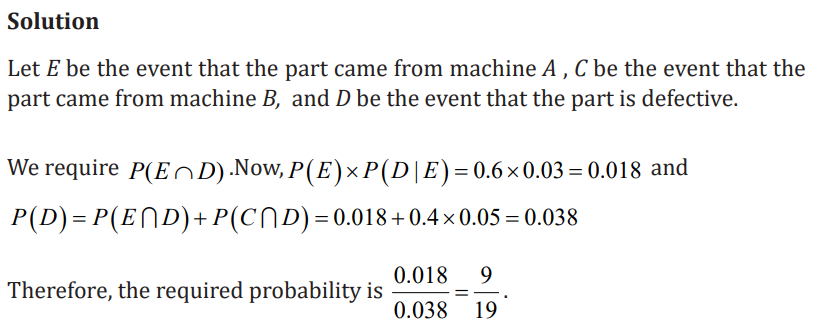
Application activity 5.1.5
1. Calculate the probability of three coins landing on: Three heads.
2. A class consists of six girls and 10 boys. If a committee of three
is chosen at random, find the probability of: a) Three boys being
chosen, b) exactly two boys and a girl being chosen. Exactly twogirls and a boy being chosen, d) three girls being chosen.
3. A bag contains 7 discs, 2 of which are red and 5 are green. Two discs
are removed at random and their colours noted. The first disk is not
replaced before the second is selected. Find the probability that thediscs will be
a) both red, b) of different colours, c) the same colours.
4. Three discs are chosen at random, and without replacement, from a
bag containing 3 red, 8 blue and 7 white discs. Find the probability
that the discs chosen will bea) all red b) all blue c) one of each colour.
5. 20% of a company’s employees are engineers and 20% are
economists. 75% of the engineers and 50% of the economists hold
a managerial position, while only 20% of non-engineers and non-
economists have a similar position. What is the probability that
an employee selected at random will be both an engineer and amanager?
6. The probability of having an accident in a factory that triggers an
alarm is 0.1. The probability of its sounding after the event of an
incident is 0.97 and the probability of it sounding after no incident
has occurred is 0.02. In an event where the alarm has been triggered,what is the probability that there has been no accident?
5.2. Probability distributions
5.2.1 Discrete probability distribution
Learning activity 5.2.1
Learning activity 5.2.1
In City of Kigali, data were collected on the number of people who had
applied to buy shares in the Rwanda Stock Exchange. People bought
different shares although some withdrew their requests. The table belowshows the collected data.
Develop the probability distribution of the random variable defined as the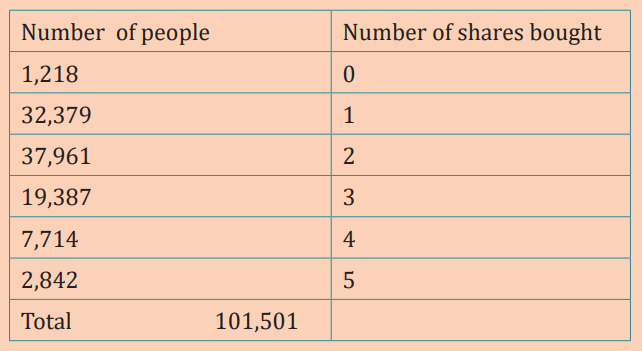
number of shares bought per person.
Probability Distribution: The values a random variable can assume and the
corresponding probabilities of each. Probability distributions are related tofrequency distributions.
For a discrete random variable x, the probability distribution is defined
by a probability function, denoted by f(x). The probability function gives theprobability for each value of the random variable. Then X is a discrete random
A discrete Variable is a variable that can take on a finite or countable number
of distinct values. It is a variable that is characterized by gaps in the values itcan take.
Examples
– number of heads observed in an experiment that flips a coin 10 times,
– number of times a student visits the library;– number of children in class
A discrete probability distribution consists of the values a random variable
can assume and the corresponding probabilities of the values. The probabilitiesare determined theoretically or by observation.
Two Requirements for a Probability Distribution are
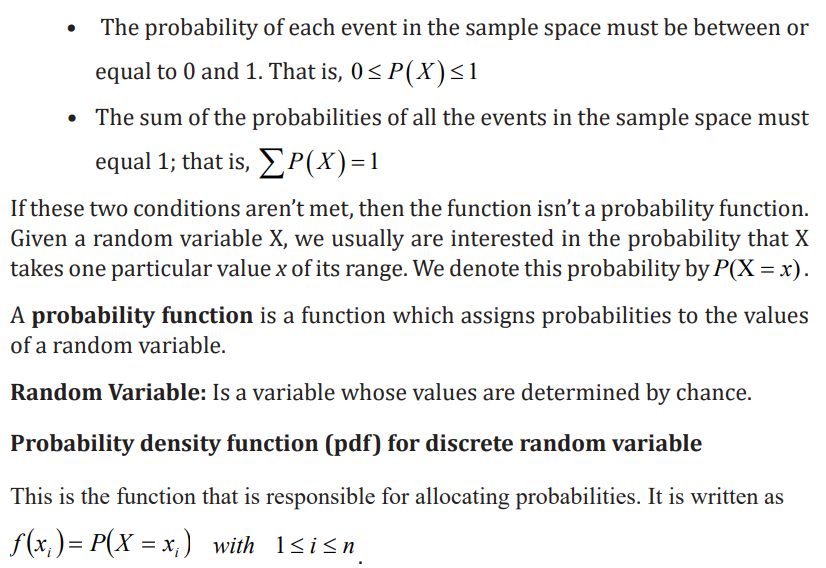
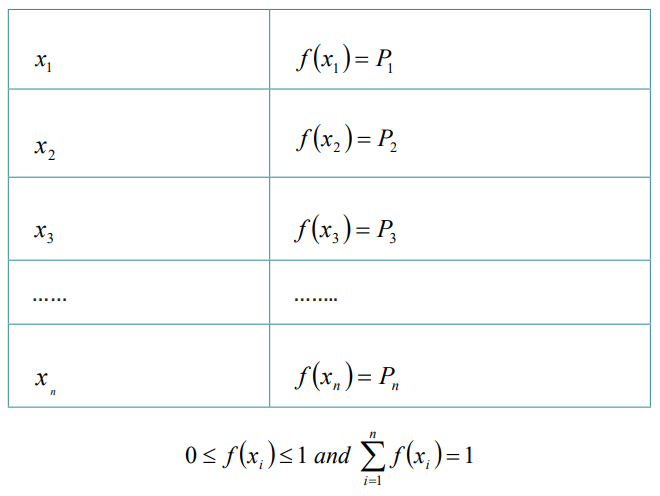
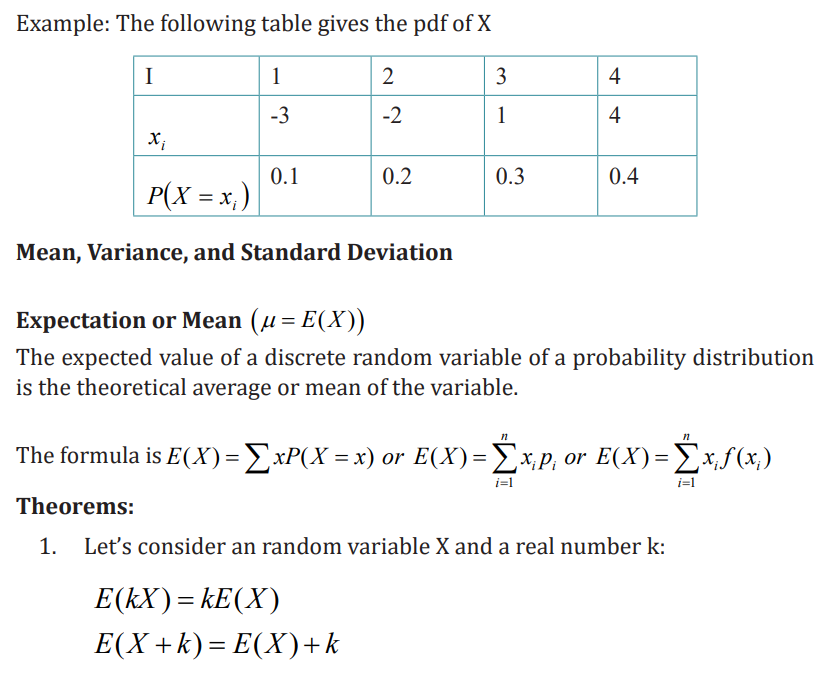

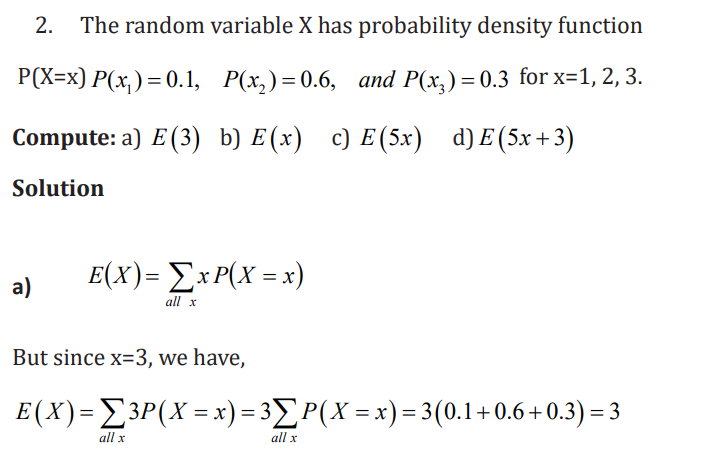

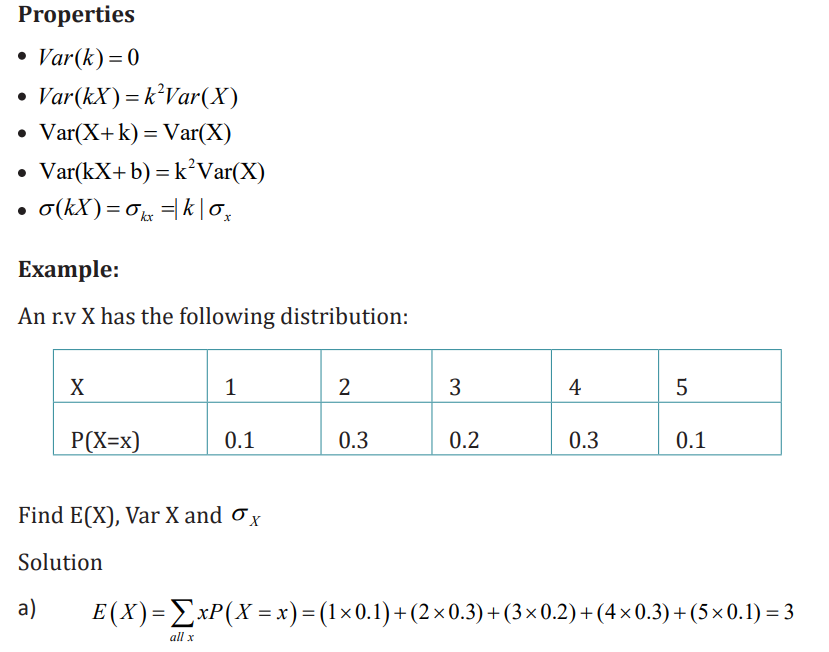

Application activity 5.2.1
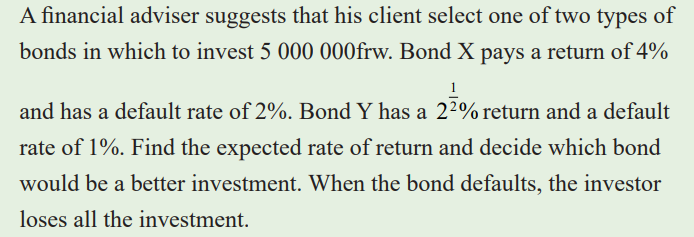
5.2.2 Binomial Distribution
Learning activity 5.2.2
With your potential explanations and examples to fit the following fourconditions:
• A fixed number of trials
• Each trial is independent of the others
• There are only two outcomes
• The probability of each outcome remains constant from trial totrial.
Binomial distribution is calculated by multiplying the probability of success raised
to the power of the number of successes and the probability of failure raised to thepower of the difference between the number of successes and the number of trials.
Let consider an experiment with independent trials and only two possible


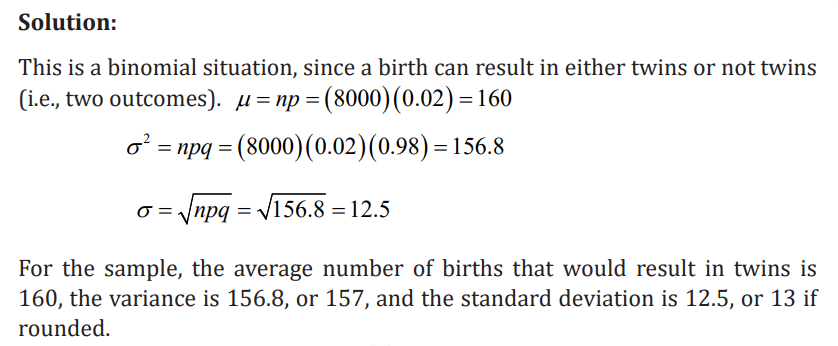
Application activity 5.2.2
1. A multiple-choice test with 20 questions has five possible answers
for each question. A completely unprepared student picks the
answers for each question at random and independently. SupposeX is the number of questions that the student answers correctly.
Calculate the probability that:
a) The student gets every answer wrong.
b) The student gets every answer right.c) The student gets 8 right answers.
2. An examination consisting of 10 multiple choice questions is to
be done by a candidate who has not revised for the exam. Eachquestion has five possible answers out of which only one is correct.
The candidate simply decides to guess the answers.
i. What is the probability that the candidate gets no answer correct?
ii. What is the probability that the student gets two correct answers?
3. Suppose you took three coins and tossed them in the air.
a) show all the possible outcomes when the coin is tossed
b) What is the probability that all three will come up heads?
c) What is the probability of 2 heads?
d) Show the probability distribution on a graph (use the number ofheads)
5.2.3 Bernoulli distribution
Learning activity 5.2.3
On your own, can you suggest the Bernoulli examples, using the binomialexperiment shown above? What are your differences and Similarities?
A Bernoulli distribution is a discrete probability distribution for a Bernoulli
trial. A Bernoulli trial is one of the simplest experiments you can conduct. It’s
an experiment where you can have one of two possible outcomes. For example,“Yes” and “No” or “Heads” and “Tails.
A random experiment that has only two outcomes (usually called a “Success”
or a “Failure”). For example, the probability of getting a heads (a “success”)
while flipping a coin is 0.5. The probability of “failure” is 1 – P (1 minus the
probability of success, which also equals 0.5 for a coin toss). It is a special case of
the binomial distribution for n 1 = . In other words, it is a binomial distributionwith a single trial (e.g. a single coin toss).
For example
In the following Bernoulli distribution, the probability of success (1) is 0.4, andthe probability of failure (0) is 0.6
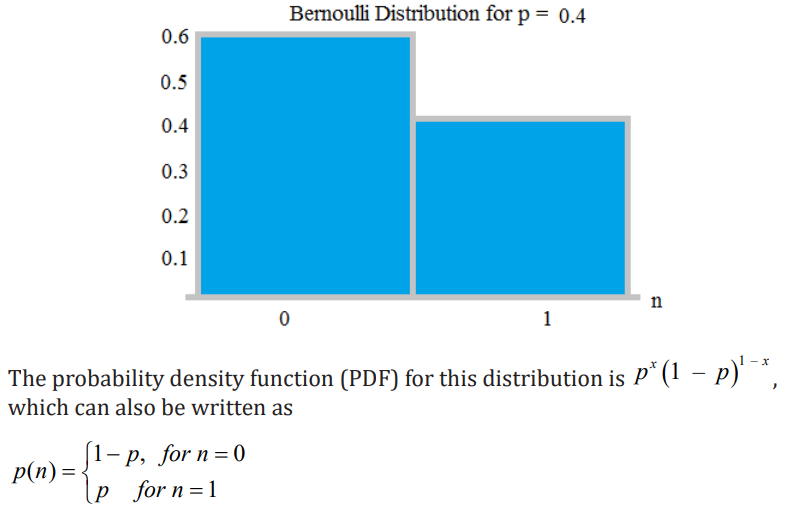

Application activity 5.2.3
Provide any examples describing discrete not continuous data resulting
from an experiment known as Bernoulli process/trials in your areas ofinterest as accounting professional.
5.2.4 Poison distribution
Learning activity 5.2.4
Describe the characteristics of the following examples:
a) The number of cars arriving at a service station in 1 hour;
b) The number of accidents in 1 day on a particular stretch of high way.
c) The number of visitors arriving at a party in 1 hour,
d) The number of repairs needed in 10 km of road,
e) The number of words typed in 10 minutes.f) Why these skills and knowledge are needed in Accounting professional.
Considering the binomial distribution, the values of p and q and n are given.
If there are cases where p is very small and n is very large, then calculation
involved will be long. Such cases will arise in connection with rare events, forexample.
• Persons killed in road accidents;
• The number of defective articles produced by a quality machine;
• The number of mistakes committed by a good typist, per page;
• The number of persons dying due to rare disease or snake bite;
• The number of accidental deaths by falling from trees or roofs etc.
In all these cases we know the number of times an event happened but not
how many times it does not occur. Events of these types are further illustratedbelow:
1. It is possible to count the number of people who died accidently by
falling from trees or roofs, but we do not know how many people did notdie by these accidents.
2. It is possible to know or to count the number of earth quakes that
occurred in an area during a particular period of time, but it is, more or
less, impossible to tell as to how many times the earth quakes did notoccur.
3. It is possible to count the number of goals scored in a foot-ball match butcannot know the number of goals that could have been but not scored.
4. It is possible to count the lightning flash by a thunderstorm but it is
impossible to count as to how many times, the lightning did not flash etc.
Thus n, the total of trials in regard to a given event is not known, the binomialdistribution is inapplicable,
Poisson distribution is made use of in such cases where p is very small. We
mean that the chance of occurrence of that event is very small. The occurrence
of such events is not haphazard. Their behavior can also be explained by
mathematical law. Poisson distribution may be obtained as a limiting case ofbinomial distribution.
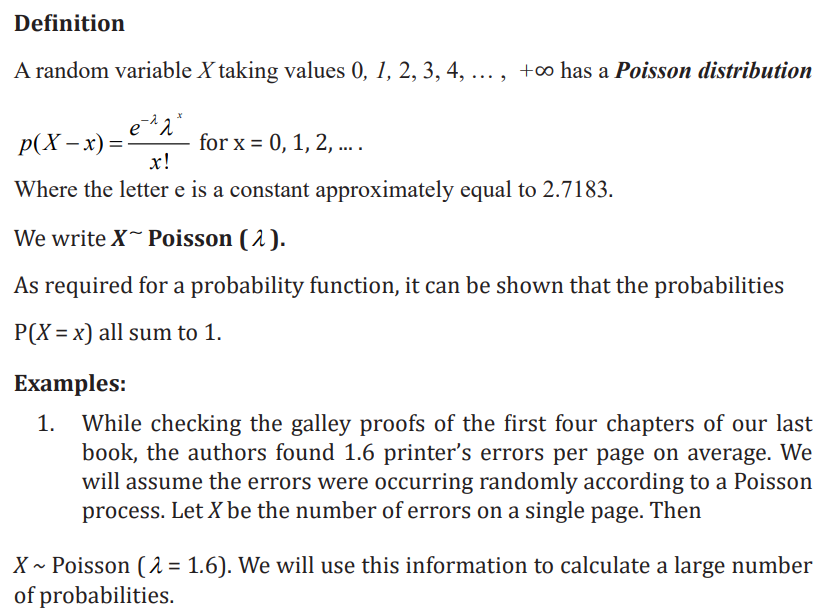
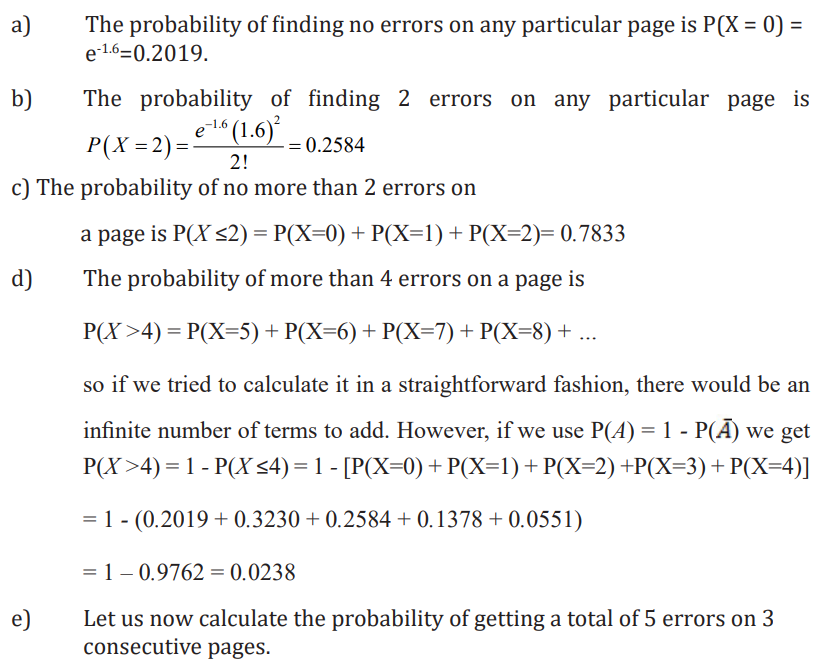

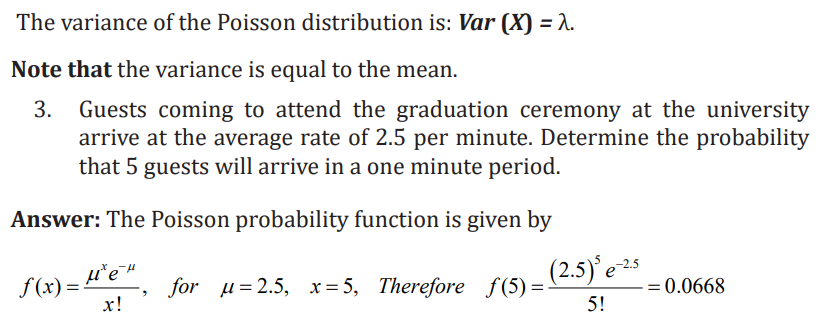
Application activity 5.2.4
1. A lecturer of statistics has observed that the number of typing
errors in new edition of text books varies considerably from book to
book. After some analysis we conclude that the number of errors is
a Poisson distribution with a mean 1.5 per 100 pages. The lecturer
randomly selects 100 pages of a new book. What is the probabilitythat there are no typing errors?
2. If there are 200 typographical errors randomly distributed in a 500-
page manuscript, find the probability that a given page containsexactly 3 errors.
3. The mean number of bacteria per millimeter of a liquid is known
to be 4. Assuming that the number of bacteria follows a Poisson
distribution, find the probability that 1 ml of liquid there will be: Nobacteria, 4 bacteria, less than 3 bacteria
5.2.5 Continuous Probability Distributions
Learning activity 5.2.5
A continuous random variable is a theoretical representation of a continuous
variable such as height, mass or time.
Examples
• the amount of time to complete a task.
• Heights of trees in a school garden
• Daily temperature• Interest earned daily on bank loans per person

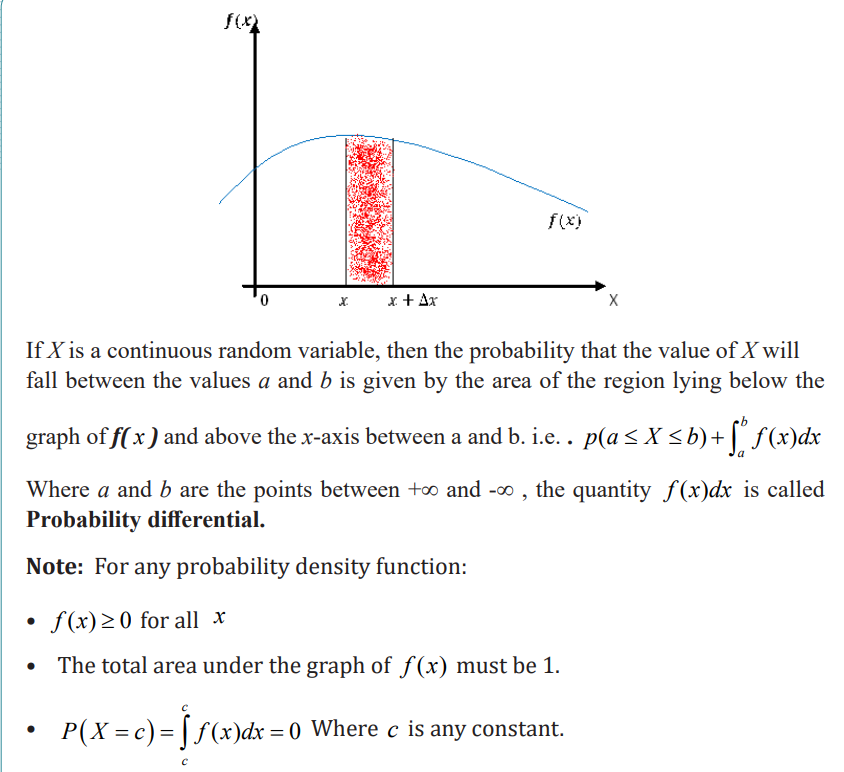
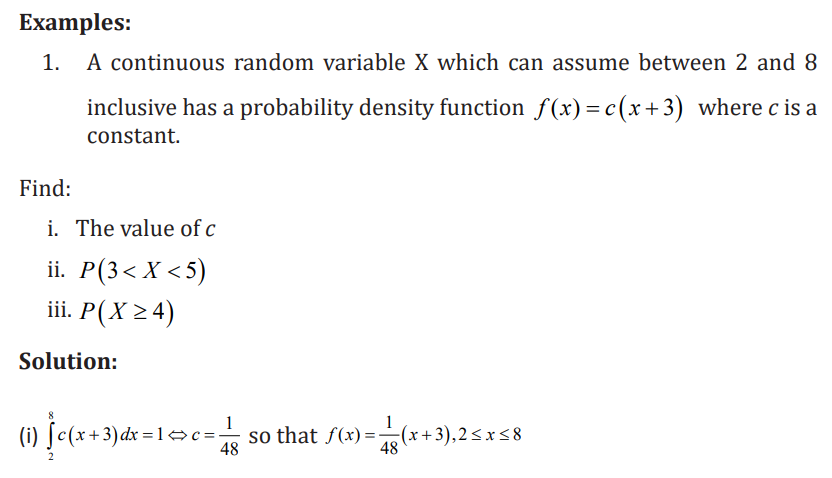
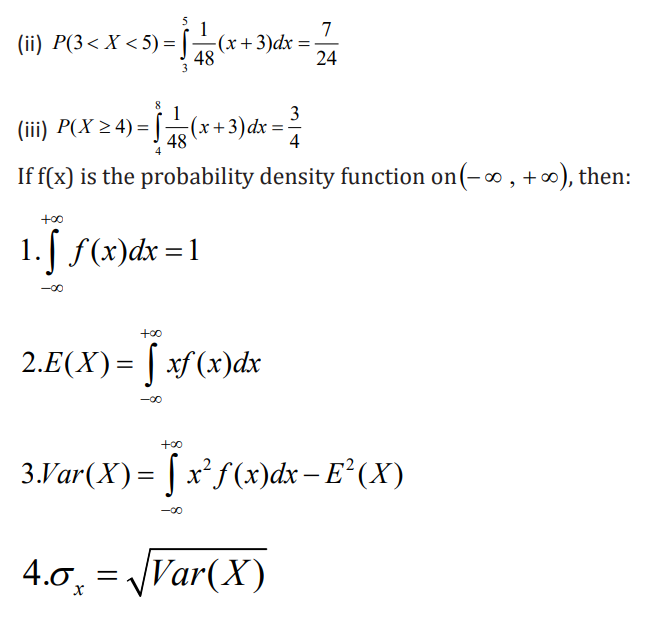
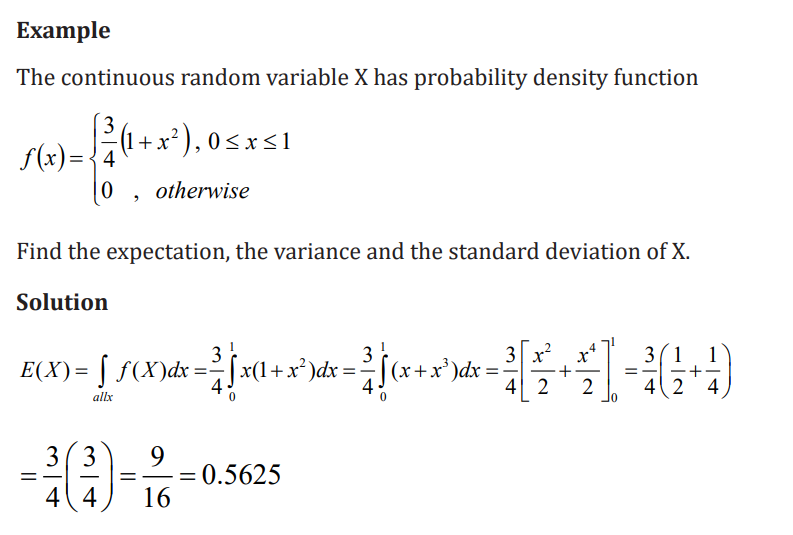

Application activity 5.2.5

5.2.6 Normal distribution
Learning activity 5.2.6
Explain clearly the results shown above, how these findings are linked to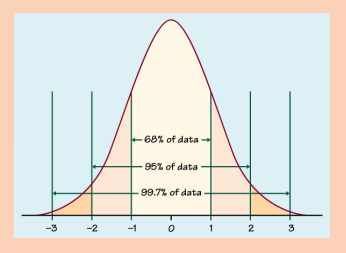
probability distributions? Can you compare descriptive statistics and thisprobability distribution as an accountant? How?
Definitions
A normal distribution is a continuous, symmetric, bell-shaped distribution ofa variable.
Standard Error or the Mean: The standard deviation of the sampling
distribution of the sample means. It is equal to the standard deviation of thepopulation divided by the square root of the sample size.
Standard Normal Distribution: A normal distribution in which the mean
is 0 and the standard deviation is 1. It is denoted by z and Z score is used to
represent the standard normal distribution.The formula for the standard normal distribution is
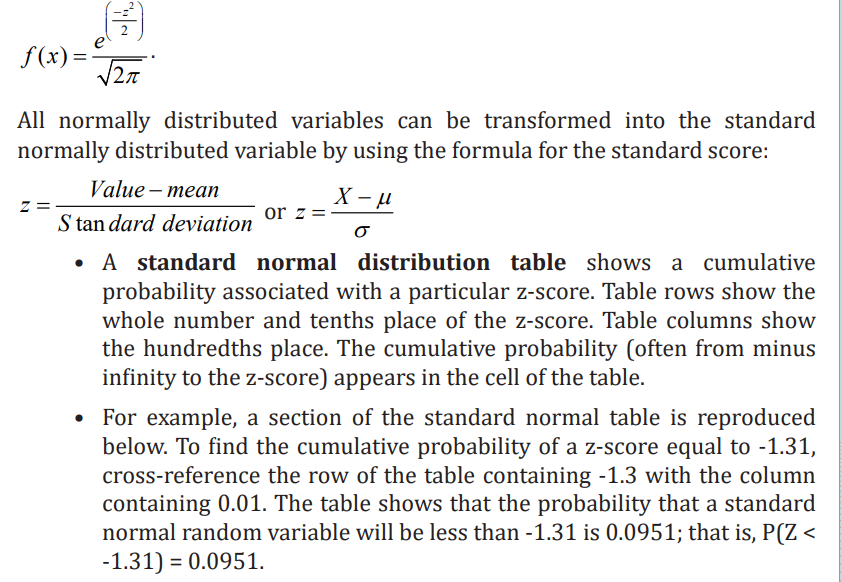
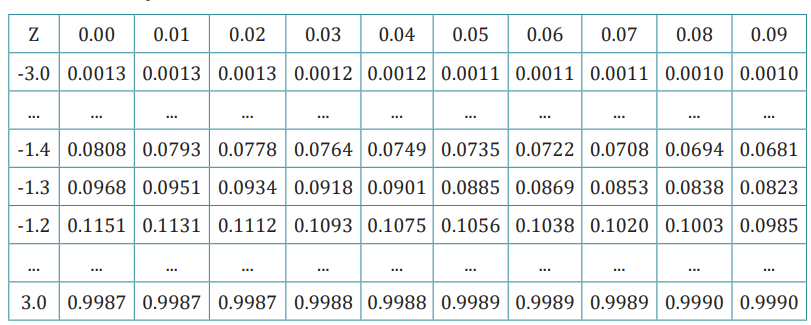
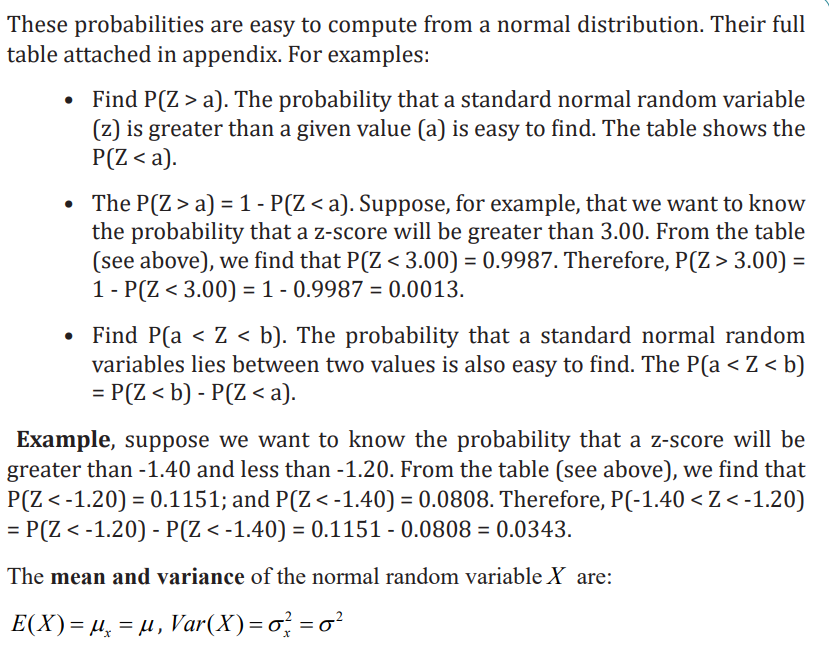
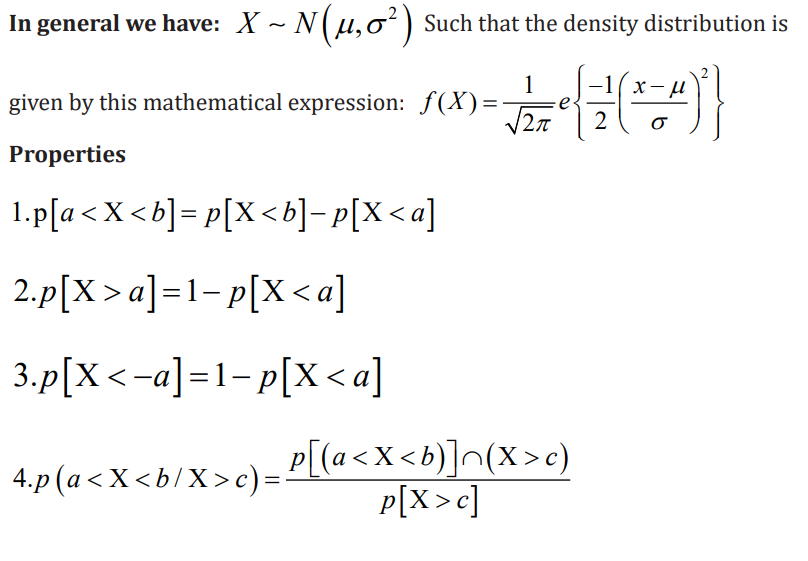

Examples:
1. The age of the subscribers to a newspaper has a normal distribution with
mean 50 years and standard deviation 5 years. Compute the percentage
of subscribers who are less than 40 years old and the percentage of whoare between 40 and 60 years old.
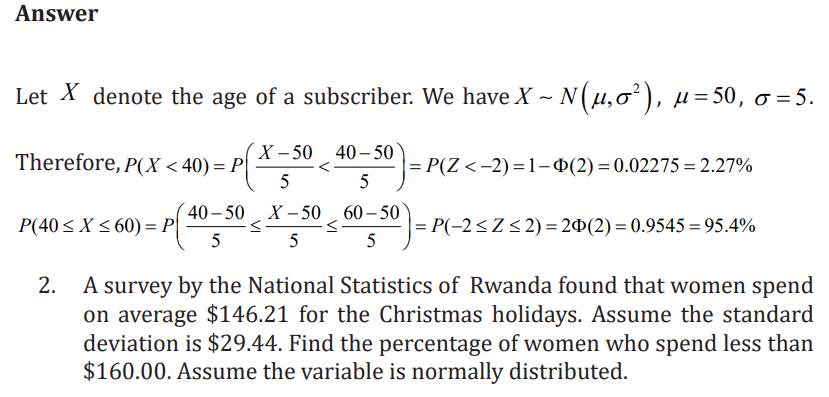
Solution:
Step 1 Draw the figure and represent the area as shown in the following figure
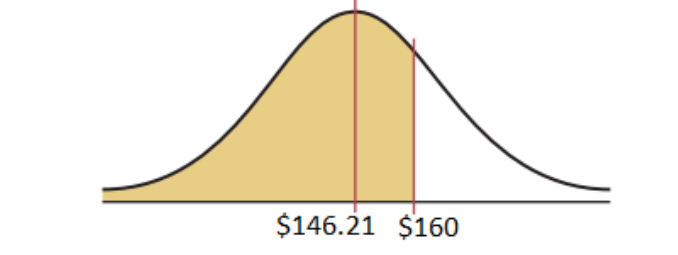

Step 3
Find the area, using the table which is on appendix of this student book. The
area under the curve to the left of z = 0.47 is 0.6808. Therefore 0.6808, or68.08%, of the women spend less than $160.00 at Christmas time.
Application activity 5.2.6
5.3. Applications of probability and probability distributions
in finance, economics, businesses, and production relateddomain.
Learning activity 5.3
1. The Trucks packed goods stayed at MAGERWA for under clearing
process in certain days. The number of days shown in the distribution aredisplayed in the table below:
Find these probabilities: (a) A Truck stayed exactly 5 days. (b) A Truck stayed
less than 6 days. (c) A Truck stayed at most 4 days. (d) A Truck stayed at least5days
Probability is essential in all aspects of human activities. Through this, we
can calculate families welfare, get information on different aspects of life and
planification in order to predict the future. It is very important to incorporate
probability with their properties looking at distributions to adresss these real-world issues. Therefore, probability play a great role for decision makers
Examples:
1. In Economics, A welfare of families depending on family planning. A woman
planning her family considers the following schemes on the assumption thatboys and girls are equally likely at each delivery:
a) Have three children.
b) Bear children until the first girl is born or until three are born, whichever
is sooner, and then stop.
c) Bear children until there is one of each sex or until there are three,whichever is sooner, and then stop.
there are equal numbers of male and female drivers insured with the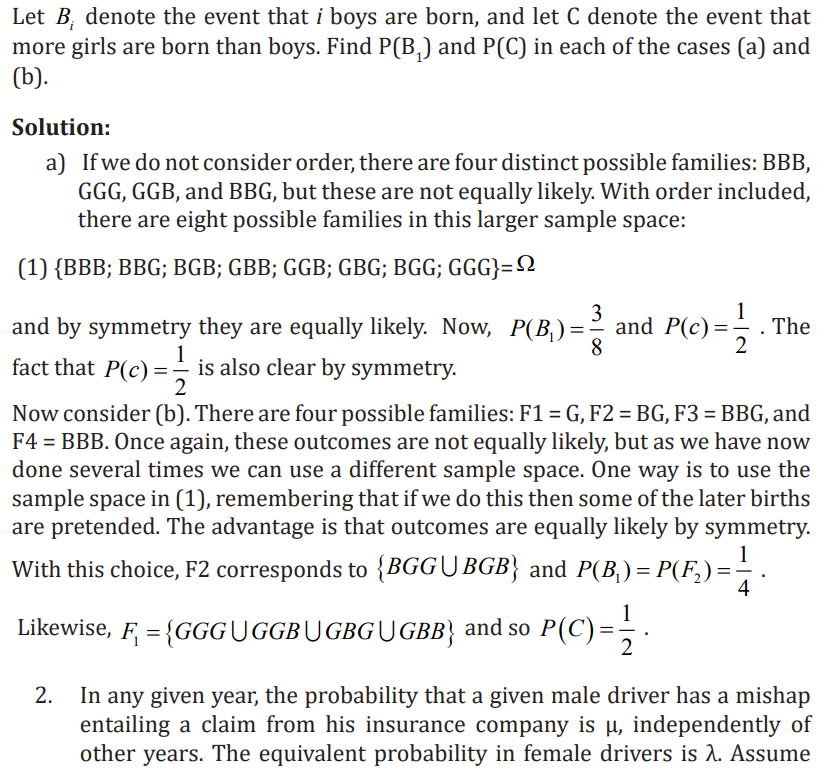
Assurance Association, which selects one of them at random.
a) What is the probability that the selected driver makes a claim this year?
b) What is the probability that the selected driver makes a claim in twoconsecutive years?
c) If the insurance company picks a claimant at random, what is theprobability that this claimant makes another claim in the following year?
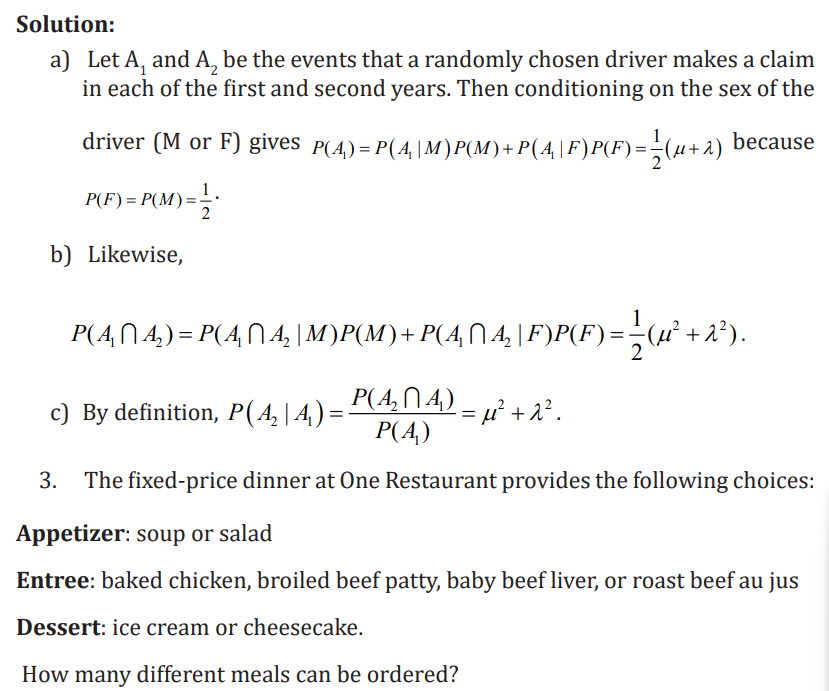
Solution:
Ordering such a meal requires three separate decisions:
Choose an Appetizer: 2 choices. Choose an Entrée: 4 choices. Choose aDessert: 2 choices.
Look at the tree diagram in the following figure. We see that, for each choice of
appetizer, there are 4 choices of entrees. And for each of these 24 8 × = choices,
there are 2 choices for dessert. A total of 2 4 2 16 ××= different meals can beordered.
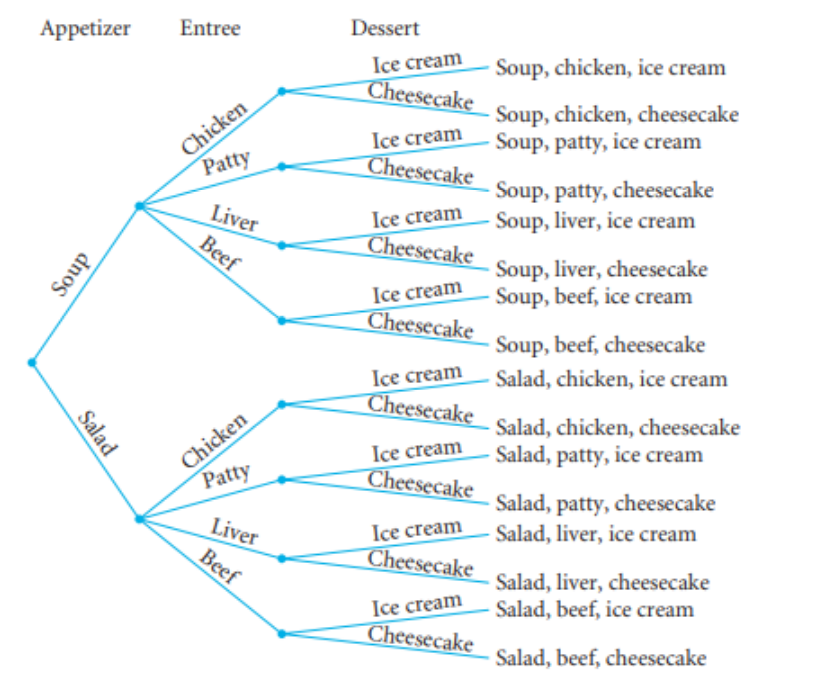
Application activity 5.3
1. An automatic Shaw machine fills plastic bags with a mixture of
beans, broccoli, and other vegetables. Most of the bags contain
the correct weight, but because of the slight variation in the size
of the beans and other vegetables, a package might be slightly
underweight or overweight. A check of 4000 packages filled in thepast month revealed:
What is the probability that a particular package will be either underweight
or overweight?
2. A baker must decide how many specialty cakes to bake each morning.
From past experience, she/he knows that the daily demand for
cakes ranges from 0 to 3.Each cake costs $3.00 to produce and
sells for $8.00, and any unsold cakes are thrown in the garbage atthe end of the day.
a) Set up a payoff table to help the baker decide how many cakes tobake
b) Assuming probability of each event is equal, determine the expectedvalue of perfect information.
5.4. End unit assessment
1. Which of the following experiments does not have equally likely
outcomes?
a) Choose a number at random between 1 and 7,
b) Toss a coin,
c) Choose a letter at random from the word SCHOOL,d) None of the above.
2. Tickets numbered 1 to 20 are mixed up and then a ticket is drawn at
random. What is the probability that the ticket drawn has a numberwhich is a multiple of 3 or 5?
3. In a class, there are 15 boys and 10 girls. Three students are
selected at random. What is the probability that 1 girl and 2 boysare selected?
4. One card is drawn at random from a pack of 52 cards. What is the
probability that the card drawn is a face card (Jack, Queen and Kingonly)?
5. The letters of the word FACETIOUS are arranged in a row. Find theprobability that
a) the first 2 letters are consonants,
b) all the vowels are together
6. At a certain school, the probability that a student takes Auditing
and Taxation is 0.087. The probability that a student takes Auditing
is 0.68. What is the probability that a student takes Taxation giventhat the student is taking Auditing?
7. A car dealership is giving away a trip to Akagera National Park to
one of their 120 best customers. In this group, 65 are women, 80
are married and 45 married women. If the winner is married, whatis the probability that it is a woman?
8. For married couples living in a certain suburb the probability that
the husband will vote on a bond referendum is 0.21, the probability
that his wife will vote in the referendum is 0.28, and the probability
that both the husband and wife will vote is 0.15. What is theprobability that
a) at least one member of a married couple will vote ?
b) a wife will vote, given that her husband will vote ?
c) a husband will vote, given that his wife does not vote ?
9. The probability that a patient recovers from a delicate heart
operation is 0.8. What is the probability that
a) exactly 2 of the next 3 patients who have this operation will survive ?
b) all of the next 3 patients who have this operation survive ?
Bibliography
1. Allan G. B. (2007). Elementary statistics: a step by step approach, seventhedition, Von Hoffmann Press, New York.
2. David F. Groebner, (2008),Business Statistics-Decision Making, 7th edition.Prentice Hall.
3. David R. (2000). Higher GCSE Mathematics, revision and Practice. OxfordUniversity Press, UK.
4. David Rayner, Higher GCSE Mathematics, Oxford University Press 2000
5. Douglas A. Lind, William G. Marchal and Robert D. Mason, (2002),
Statistical Techniques in Business & Economics,11th edition, New York,McGraw-Hill Irwin.
6. Frank Ebos, Dennis Hamaguchi, Barbana Morrison & John Klassen,
Mathematics Principles & Process, Nelson Canada A Division ofInternational Thomson Limited 1990
7. Geoff Mannall & Michael Kenwood, Pure Mathematics 2, HeinemannEducational Publishers 1995
8. George B. Thomas, Maurice D. Weir & Joel R. Hass, Thomas’ CalculusTwelfth Edition, Pearson Education, Inc. 2010
9. Gerald Keller, Brian Warrack, (2003), Statistics for Management andEconomics, 6th edition, Duxbury Thomson Learning, Pacific Grove.
10. https://www.brainkart.com. Business mathematics 11th std. cost functionfrom marginal cost function
11. https://www.google.com/search? q=application +of+probability+
in+business&oq=&aqs=chrome. 0.35i39i362l5 j46i39i362j35i39i3
62l2.257365776 j0j15&sourceid = chrome&ie=UTF-8, retrieved 4th, Feb,2024
12. https://www.johndcook.com/blog/forecasting/ , retrieved 4th, Feb 2024
13. J CRAWSHAW, J CHAMBERS: A concise course in A-Level statistics withworked examples, Stanley Thornes (Publishers) LTD, 1984.
14. J. CRAWSHAW and J. CHAMBERS 2001. A concise course in Advanced LevelStatistics with worked examples 4th Edition. Nelson Thornes Ltd, UK.
15. J. Sadler, D. W. S. Thorning: Understanding Pure Mathematics, OxfordUniversity Press 1987.
16. James T. McClave, P. George Benson and Terry Sincich, (2008), Statistics forBusiness and Economics, Prentice Hall.
17. James T. McClave, P.George Benson. Statistics for Business and Economics.USA, Dellen Publishing Company, a division of Macmillan, Inc 1988.
18. James T. McClave, P.George Benson. Statistics for Business and Economics.USA, Dellen Publishing Company, a division of Macmillan, Inc 1988.
19. Jean-Philippe RÉAU and Gérard CHAUVAT, (1999), Probabilités &Statistiques. Armand Colin.
20. John bird. (2005). Basic engineering mathematics. 4th Edition. LinacreHouse, Jordan Hill, Oxford OX2 8DP
21. K.A. Stroud. (2001). Engineering mathematics. 5th Edition. Industrial Press,Inc, New York
22. Ngezahayo E.(2016). Advanced Mathematics for Rwanda secondarySchools, Learners’ book 4, Fountain publishers, Kigali.
23. Ngezahayo E.(2016). Advanced Mathematics for Rwanda secondarySchools, Learners’ book 4, Fountain publishers, Kigali.
24. Ngezahayo E.(2016). Subsidiary Mathematics for Rwanda secondarySchools, Learners’ book 4, Fountain publishers, Kigali.
25. Ngezahayo E.(2017). Advanced Mathematics for Rwanda secondarySchools, Learners’ book 5, Fountain publishers, Kigali.
26. Ngezahayo E.(2017). Subsidiary Mathematics for Rwanda secondarySchools, Learners’ book 5, Fountain publishers, Kigali.
27. Ngezahayo E.(2017). Subsidiary Mathematics for Rwanda secondarySchools, Learners’ book 5, Fountain publishers, Kigali.
28. Ngezahayo E.(2018). Advanced Mathematics for Rwanda secondarySchools, Learners’ book 6, Fountain publishers, Kigali.
29. Ngezahayo E.(2018). Advanced Mathematics for Rwanda secondarySchools, Learners’ book 6, Fountain publishers, Kigali.
30. Norman L. Johnson, Samuel Kotz and Adrienne W. Kemp, (1992). UnivariateDiscrete Distributions, 2nd Edition. John Wiley & Son.
31. Peter S. (2005). Mathematics HL&SL with HL options, Revised edition.Mathematics Publishing PTY. Limited.
32. Peter Smythe: Mathematics HL & SL with HL options, Revised Edition,Mathematics Publishing Pty. Limited, 2005.
33. REB (2020), Mathematics for TTCs year three, Science and MathematicsEducation (SME), Kigali, Rwanda
34. REB (2020), Mathematics for TTCs year three, social studies education(SSE), Kigali, Rwanda
35. REB. (2015). Subsidiary Mathematics Syllabus, MINEDUC, Kigali, Rwanda.
36. REB. (2019). Mathematics Syllabus for TTC-Option of LE, MINEDUC, KigaliRwanda.
37. S. Brown and W. K. Wong, (2015). Probability and Statistics with
Applications in Finance and Economics, Hindawi, The Scientific WorldJournal 2015:618785, DOI: 10.1155/2015/618785, License CC BY
38. Sadler A. J & Thorning D.W. (1997). Understanding Pure mathematics,Oxford university press, UK.
39. Seymour Lipschutz, PhD. & Marc Lipson, PhD. (2007). Discrete mathematics.3rd edition.
40. Seymour Lipschutz. Schaum’s outline of Theory and Problems of FiniteMathematics. New York, Schaum Publisher, 1966
41. Shampiyona Aimable : Mathématiques 6. Kigali, Juin 2005.
42. Wellars Banzi, and Nteziyaremye Stanislas, (2023). Business Research
Methodology and Operations Research Lectures note, Republic of Rwanda,Kigali Independent University.

